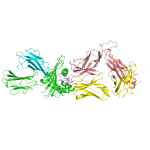
In a previous post I questioned whether ovarian cancer is being under-served by personalized medicine, and promised to dig a bit deeper into some of the advancements that ARE being made for this disease.
The first pass has been to look at targeted therapeutics, and one of the more active areas for ovarian cancer seems to be immunotherapies that target the cancer antigen NY-ESO-1 (gene ID CTAG1B).
Healthy adults only express this protein in the testis and ovaries, and only in germ cells (where it is strongly expressed). It also happens to be expressed on the surface of cancer cells in a multitude of cancer types, including ovarian cancer, and it also happens to be highly antigenic, eliciting a strong response from the immune system, thus representing an attractive target for immunotherapies.
NY-ESO-1 was first discovered by the Ludwig Institute for Cancer Research (LICR) in 1998, and as an antigen has been utilized in 18 listed clinical trials for ovarian cancer dating back to 2003 (five of which have been sponsored or co-sponsored by LICR).
NY-ESO-1 is used in subtly different ways in these trials, but most approaches seek to activate the immune system within the tumor’s highly anti-immune environment, most commonly by binding the cancer cells to dendritic cells through the DEC-205 receptor, or by binding them directly to T cells through T cell receptors (TCR).
There are currently 7 active clinical trials for ovarian cancer that use NY-ESO-1 as an inclusion criterion.
Adaptimmune is using a TCR approach, and while the company’s phase 1/2 trial for ovarian cancer is still underway, the results from the first clinical trial using the approach (for synovial sarcoma) are encouraging.
Celldex Therapeutics is using the DEC-205 approach, and has published positive results from its first trial for ovarian cancer.
Immune Design is using a novel approach to NY-ESO-1 utilization, whereby a synthetic molecule is used to activate toll-like receptor activity, in turn boosting dendritic cell activity. Immune Design is actively recruiting for not one but twoclinical trials utilizing this therapeutic approach.
